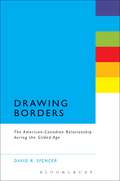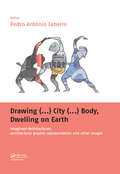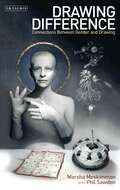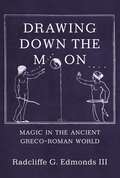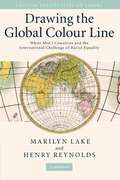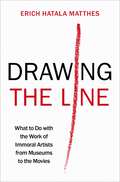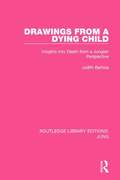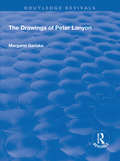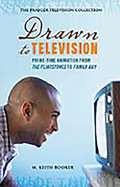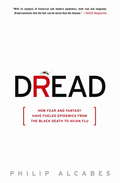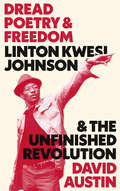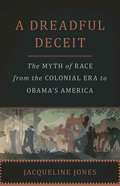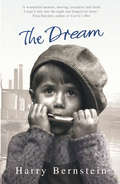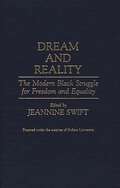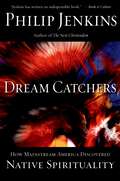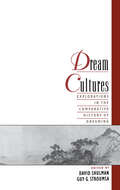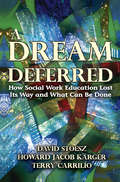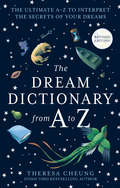- Table View
- List View
Drawing Borders: The American-Canadian Relationship during the Gilded Age
by David R. SpencerCanada has not always had the role of 'friendly neighbor to the north.' In fact, the seemingly peaceful history of relations between the United States and Canada is punctuated with instances of border disputes, annexation manifestos and trade disagreements. David R. Spencer reveals the complexity of this relationship through a fascinating examination of political cartoons that appeared both in the U.S. and Canada from 1849 through the 1990s. By first examining both the cultural and political differences and similarities between the two nations, Spencer lays the groundwork for the main focus of his study - deeper analysis of the political perspectives of the editorial cartoons. Including 141 actual cartoons of the time, Spencer provides meaningful references to the historical material covered. An intriguing study by a leading Canadian-American scholar, this work is sure to interest many across the disciplines of journalism history, cartoons, media studies, communication and international relations.
Drawing Borders: The American-Canadian Relationship during the Gilded Age
by David R. SpencerCanada has not always had the role of 'friendly neighbor to the north.' In fact, the seemingly peaceful history of relations between the United States and Canada is punctuated with instances of border disputes, annexation manifestos and trade disagreements. David R. Spencer reveals the complexity of this relationship through a fascinating examination of political cartoons that appeared both in the U.S. and Canada from 1849 through the 1990s. By first examining both the cultural and political differences and similarities between the two nations, Spencer lays the groundwork for the main focus of his study - deeper analysis of the political perspectives of the editorial cartoons. Including 141 actual cartoons of the time, Spencer provides meaningful references to the historical material covered. An intriguing study by a leading Canadian-American scholar, this work is sure to interest many across the disciplines of journalism history, cartoons, media studies, communication and international relations.
Drawing (...) City (...) Body, Dwelling on Earth: Imagined-Architectures: Architectural Graphic Representation and Other Images
by Pedro António JaneiroThis international seminar’s fifth edition, dedicated to the theme Desenho (...) Cidade (…) Corpo, Habitando a Terra (Drawing […] City […] Body, Inhabiting the Earth) was held as a joint activity between: this C.I.A.U.D./F.A./U.Lisboa Research Project, the University of São Paulo, represented by the Maria Antônia University Centre, and the Faculty of Architecture and Urbanism of the Federal University of Juiz de Fora. Its objectives were threefold: To discuss how Drawing in/of the City and the elements that identify it (geographical area, inhabitants, natural landscape and/or built landscape; present, desired or memorable facts and data) are represented and identified through the presence and/or action of the body, in the form of gestures, movements, interventions, displacements or permanence. To problematise the association between Drawing and City from the starting point of the perception of the Body, assuming this mediation as a condition for the particular construction of that relationship. To identify the presence of the Body in the Representations/Drawings of the City, submitting this event or phenomenon to analysis, aiming for cognitive production. The contributions will be of interest to artists, academics and professionals in the fields of drawing and the arts, architecture, sociology, philosophy, urbanism and design.
Drawing Difference: Connections Between Gender and Drawing
by Marsha Meskimmon Phil SawdonDrawing has been growing in recognition and stature within contemporary fine art since the mid-1970s. Simultaneously, feminist activism has been widespread, leading to the increased prominence of women artists, scholars, critics and curators and the wide acknowledgement of the crucial role played by gender and sexual difference in constituting the subject. Drawing Difference argues that these developments did not occur in parallel simply by coincidence. Rather, the intimate interplay between drawing and feminism is best characterised as allotropic a term originating in chemistry that describes a single pure element which nevertheless assumes varied physical structures, denoting the fundamental affinities which underlie apparently differing material forms. The book takes as its starting point three works from the 1970s by Annette Messager, Dorothea Rockburne and Carolee Schneeman, that are used to exemplify critical developments in feminist art history and key moments for drawing as a means of expression.Throughout the chapters, these works are further explored in relation to the contemporary drawing practices of Marco Maggi, Sian Bowen, Susan Hauptmann, Cornelia Parker, Christoph Fink and Toba Kheedori. Their works are shown to be (re)iterative sites where mark-making differs with each appearance yet retains certain essential features. Dividing its analysis into the themes Approaching, Tropes and Coinciding, the book analyses how both drawing and feminist discourse emphasise dialogue, matter and openness. It demonstrates how sexual difference, subjectivity and drawing are connected at an elemental level and thus how drawing has played a vital role in the articulation of the material and conceptual dynamics of feminism."
Drawing Down the Moon: Magic in the Ancient Greco-Roman World
by III Radcliffe G. Edmonds IIIAn unparalleled exploration of magic in the Greco-Roman worldWhat did magic mean to the people of ancient Greece and Rome? How did Greeks and Romans not only imagine what magic could do, but also use it to try to influence the world around them? In Drawing Down the Moon, Radcliffe Edmonds, one of the foremost experts on magic, religion, and the occult in the ancient world, provides the most comprehensive account of the varieties of phenomena labeled as magic in classical antiquity. Exploring why certain practices, images, and ideas were labeled as “magic” and set apart from “normal” kinds of practices, Edmonds gives insight into the shifting ideas of religion and the divine in the ancient past and in the later Western tradition.Using fresh approaches to the history of religions and the social contexts in which magic was exercised, Edmonds delves into the archaeological record and classical literary traditions to examine images of witches, ghosts, and demons as well as the fantastic powers of metamorphosis, erotic attraction, and reversals of nature, such as the famous trick of drawing down the moon. From prayer and divination to astrology and alchemy, Edmonds journeys through all manner of ancient magical rituals and paraphernalia—ancient tablets, spell books, bindings and curses, love charms and healing potions, and amulets and talismans. He considers the ways in which the Greco-Roman discourse of magic was formed amid the cultures of the ancient Mediterranean, including Egypt and the Near East.An investigation of the mystical and marvelous, Drawing Down the Moon offers an unparalleled record of the origins, nature, and functions of ancient magic.
Drawing Europe Together: Forty-five Illustrators, One Europe
by VariousAre we still 'United in Diversity'? Forty-five artists from across Europe share their powerful illustrations of the European Union's shared past and our unsure future. From Brexit bees to wall-jumping bulls, Drawing Europe Together is a unique collection portraying the European community . . . with or without Britain.This is a passionate and heartfelt exploration of Europe and what it means to many of the people who live and work within its borders. The book brings together forty-five renowned illustrators who, through their drawings and accompanying words, share their vision of Europe in this beautiful and timely collection, with a foreword by the British Book Awards Illustrator of the Year 2018, Axel Scheffler.Inspired by the Drawing (for) Europe exhibition which took place at the Institut Français in London in 2018, Drawing Europe Together showcases the original artwork from the exhibition as well as never-before-seen illustrations from additional leading artists. With contributions from many of the world’s best book illustrators including Quentin Blake, Claude Dubois, Jim Field, Emily Gravett, Judith Kerr, Oliver Jeffers, Sarah McIntyre, Lydia Monks, Thomas Müller and Chris Riddell.
Drawing the Global Colour Line: White Men's Countries and the International Challenge of Racial Equality (PDF) (Critical Perspectives On Empire Ser.)
by Marilyn Lake Henry ReynoldsIn 1900 W. E. B. DuBois prophesied that the colour line would be the key problem of the twentieth-century and he later identified one of its key dynamics: the new religion of whiteness that was sweeping the world. Whereas most historians have confined their studies of race-relations to a national framework, this book studies the transnational circulation of people and ideas, racial knowledge and technologies that under-pinned the construction of self-styled white men's countries from South Africa, to North America and Australasia. Marilyn Lake and Henry Reynolds show how in the late nineteenth century and early twentieth century these countries worked in solidarity to exclude those they defined as not-white, actions that provoked a long international struggle for racial equality. Their findings make clear the centrality of struggles around mobility and sovereignty to modern formulations of both race and human rights.
Drawing the Line: What to Do with the Work of Immoral Artists from Museums to the Movies
by Erich Hatala MatthesCan we still watch Woody Allen's movies? Can we still laugh at Bill Cosby's jokes? Woody Allen, Kevin Spacey, Dave Chappelle, Louis C. K., J.K. Rowling, Michael Jackson, Roseanne Barr. Recent years have proven rife with revelations about the misdeeds, objectional views, and, in some instances, crimes of popular artists. Spurred in part by the #metoo movement, and given more access than ever thanks to social media and the internet in general, the public has turned an alert and critical eye upon the once-hidden lives of previously cherished entertainers. But what should we members of the public do, think, and feel in response to these artists' actions or statements? It's a predicament that many of us face: whether it's possible to disentangle the deeply unsettled feelings we have toward an artist from how we respond to the art they produced. As consumers of art, and especially as fans, we have a host of tricky moral question to navigate: do the moral lives of artists affect the aesthetic quality of their work? Is it morally permissible for us to engage with or enjoy that work? Should immoral artists and their work be "canceled"? Most of all, can we separate an artist from their art? In Drawing the Line, Erich Hatala Matthes employs the tools of philosophy to offer insight and clarity to the ethical questions that dog us. He argues that it doesn't matter whether we can separate the art from the artist, because we shouldn't. While some dismiss the lives of artists as if they are irrelevant to the artist's work, and others instrumentalize artwork, treating it as nothing more than a political tool, Matthes argues both that the lives of artists can play an important role in shaping our moral and aesthetic relationship to the artworks that we love and that these same artworks offer us powerful resources for grappling with the immorality of their creators. Rather than shunning art made by those who have been canceled, shamed, called out, or even arrested, we should engage with it all the more thoughtfully and learn from the complexity it forces us to confront. Recognizing the moral and aesthetic relationships between art and artist is crucial to determining when and where we should draw the line when good artists do bad things.
Drawing the Line: What to Do with the Work of Immoral Artists from Museums to the Movies
by Erich Hatala MatthesCan we still watch Woody Allen's movies? Can we still laugh at Bill Cosby's jokes? Woody Allen, Kevin Spacey, Dave Chappelle, Louis C. K., J.K. Rowling, Michael Jackson, Roseanne Barr. Recent years have proven rife with revelations about the misdeeds, objectional views, and, in some instances, crimes of popular artists. Spurred in part by the #metoo movement, and given more access than ever thanks to social media and the internet in general, the public has turned an alert and critical eye upon the once-hidden lives of previously cherished entertainers. But what should we members of the public do, think, and feel in response to these artists' actions or statements? It's a predicament that many of us face: whether it's possible to disentangle the deeply unsettled feelings we have toward an artist from how we respond to the art they produced. As consumers of art, and especially as fans, we have a host of tricky moral question to navigate: do the moral lives of artists affect the aesthetic quality of their work? Is it morally permissible for us to engage with or enjoy that work? Should immoral artists and their work be "canceled"? Most of all, can we separate an artist from their art? In Drawing the Line, Erich Hatala Matthes employs the tools of philosophy to offer insight and clarity to the ethical questions that dog us. He argues that it doesn't matter whether we can separate the art from the artist, because we shouldn't. While some dismiss the lives of artists as if they are irrelevant to the artist's work, and others instrumentalize artwork, treating it as nothing more than a political tool, Matthes argues both that the lives of artists can play an important role in shaping our moral and aesthetic relationship to the artworks that we love and that these same artworks offer us powerful resources for grappling with the immorality of their creators. Rather than shunning art made by those who have been canceled, shamed, called out, or even arrested, we should engage with it all the more thoughtfully and learn from the complexity it forces us to confront. Recognizing the moral and aesthetic relationships between art and artist is crucial to determining when and where we should draw the line when good artists do bad things.
Drawings From A Dying Child: Insights Into Death From A Jungian Perspective (PDF)
by Judith BertoiaDoes a dying child understand death? How can we help children who are dying? Originally published in 1993, this book concerns a young girl, Rachel, terminally ill with leukaemia. The book describes a series of drawings she made and shows how they reveal her inner experience, how she became fully aware that she was dying and even came to accept death. The result is a moving and informative story that will be invaluable to caregivers and families with a dying child. It provides new understanding of the experience of a dying child and suggests practical strategies for coping.
The Drawings of Peter Lanyon
by Margaret GarlakeThis title was first published in 2003. Peter Lanyon stood at the forefront of landscape painting in Europe during the late 1950s and early 60s. A prominent St Ives artist, he was associated with Barbara Hepworth, Ben Nicholson and Naum Gabo; his work also has affinities with abstract expressionism. Lanyon's career started just as the study of drawing was being liberated from 19th-century academic constrictions. His many drawings range from records of trips to the Netherlands and Italy to portrait sketches and abstract studies. Lanyon also used drawings extensively in the development of some of his most important paintings. In this study, Margaret Garlake explores Lanyon's theory and practice of drawing; the contribution of drawings to the evocation of place in paintings; his use of models and the metamorphosis of the human body into landscape images, as well as his use of three-dimensional constructions as equivalents to drawing.
The Drawings of Peter Lanyon
by Margaret GarlakeThis title was first published in 2003. Peter Lanyon stood at the forefront of landscape painting in Europe during the late 1950s and early 60s. A prominent St Ives artist, he was associated with Barbara Hepworth, Ben Nicholson and Naum Gabo; his work also has affinities with abstract expressionism. Lanyon's career started just as the study of drawing was being liberated from 19th-century academic constrictions. His many drawings range from records of trips to the Netherlands and Italy to portrait sketches and abstract studies. Lanyon also used drawings extensively in the development of some of his most important paintings. In this study, Margaret Garlake explores Lanyon's theory and practice of drawing; the contribution of drawings to the evocation of place in paintings; his use of models and the metamorphosis of the human body into landscape images, as well as his use of three-dimensional constructions as equivalents to drawing.
Drawn to Television: Prime-Time Animation from The Flintstones to Family Guy (The Praeger Television Collection)
by Prof. M. Keith BookerSince late evening cartoons first aired in 1960, prime-time animated series have had a profound effect on American television and American culture at large. The characters and motifs from such shows as The Flintstones and The Simpsons are among the best-known images in world popular culture; and tellingly, even series that have not done well in prime time—series like The Jetsons, for instance—have yielded similarly iconic images. The advent of cable and several new channels devoted exclusively to animated programming have brought old series back to life in syndication, while also providing new markets for additional, often more experimental animated series. Even on the conventional networks, programs such as The Flintstonesand The Simpsons, not to mention Family Guy and King of the Hill, have consistently shown a smartness and a satirical punch that goes well beyond the norm in network programming. Drawn to Television traces the history of prime-time animation from The Flintstones initial extension of Saturday mornings to Family Guy and South Park's late-night appeal in the 21st century. In the process, it sheds a surprising light on just how much the kid inside us all still has to say.Drawn to Television describes the content and style of all the major prime-time animated series, while also placing these series within their political and cultural contexts. It also tackles a number of important questions about animated programming, such as: how animated series differ from conventional series; why animated programming tends to be so effective as a vehicle for social and political satire; what makes animated characters so readily convertible into icons; and what the likely effects of new technologies (such as digital animation) will be on this genre in the future.
Dread: How Fear and Fantasy Have Fueled Epidemics from the Black Death to Avian Flu
by Philip AlcabesDeaths from epidemic disease are rare in the developed world, yet in our technically and medically advanced society, an ever-present risk of disease has created an industry out of fear.As Philip Alcabes persuasively argues in Dread, our anxieties about epidemics often stray from the facts on the ground. In a fascinating exploration of the social and cultural history of epidemics, Alcabes delivers a different narrative of disease-one that requires that we reexamine our choice of enemies, and carefully consider the potential motivation of epidemic alarm-bells to further medical, moral, or political campaigns.
Dread Poetry and Freedom: Linton Kwesi Johnson and the Unfinished Revolution
by David AustinWhat is the relationship between poetry and social change?*BR**BR*Standing at the forefront of political poetry since the 1970s, Linton Kwesi Johnson has been fighting neo-fascism, police violence and promoting socialism while putting pen to paper to refute W.H. Auden's claim that 'poetry makes nothing happen'. For Johnson, only the second living poet to have been published in the Penguin Modern Classics series, writing has always been 'a political act' and poetry 'a cultural weapon'.*BR**BR*In Dread Poetry and Freedom - the first book dedicated to the work of this 'political poet par excellence' - David Austin explores the themes of poetry, political consciousness and social transformation through the prism of Johnson's work. Drawing from the Bible, reggae and Rastafari, and surrealism, socialism and feminism, and in dialogue with Aime Cesaire and Frantz Fanon, C.L.R. James and Walter Rodney, and W.E.B. Du Bois and the poetry of d'bi young anitafrika, Johnson's work becomes a crucial point of reflection on the meaning of freedom in this masterful and rich study.*BR**BR*In the process, Austin demonstrates why art, and particularly poetry, is a vital part of our efforts to achieve genuine social change in times of dread.
Dread Poetry and Freedom: Linton Kwesi Johnson and the Unfinished Revolution
by David AustinWhat is the relationship between poetry and social change?*BR**BR*Standing at the forefront of political poetry since the 1970s, Linton Kwesi Johnson has been fighting neo-fascism, police violence and promoting socialism while putting pen to paper to refute W.H. Auden's claim that 'poetry makes nothing happen'. For Johnson, only the second living poet to have been published in the Penguin Modern Classics series, writing has always been 'a political act' and poetry 'a cultural weapon'.*BR**BR*In Dread Poetry and Freedom - the first book dedicated to the work of this 'political poet par excellence' - David Austin explores the themes of poetry, political consciousness and social transformation through the prism of Johnson's work. Drawing from the Bible, reggae and Rastafari, and surrealism, socialism and feminism, and in dialogue with Aime Cesaire and Frantz Fanon, C.L.R. James and Walter Rodney, and W.E.B. Du Bois and the poetry of d'bi young anitafrika, Johnson's work becomes a crucial point of reflection on the meaning of freedom in this masterful and rich study.*BR**BR*In the process, Austin demonstrates why art, and particularly poetry, is a vital part of our efforts to achieve genuine social change in times of dread.
A Dreadful Deceit: The Myth of Race from the Colonial Era to Obama's America
by Jacqueline JonesIn 1656, a planter in colonial Maryland tortured and killed one of his slaves, an Angolan man named Antonio who refused to work the fields. Over three centuries later, a Detroit labor organizer named Simon Owens watched as strikebreakers wielding bats and lead pipes beat his fellow autoworkers for protesting their inhumane working conditions. Antonio and Owens had nothing in common but the color of their skin and the economic injustices they battled-yet the former is what defines them in America’s consciousness. In A Dreadful Deceit, award-winning historian Jacqueline Jones traces the lives of these two men and four other African Americans to reveal how the concept of race has obscured the factors that truly divide and unite us. Expansive, visionary, and provocative, A Dreadful Deceit explodes the pernicious fiction that has shaped American history.
The Dream: A Memoir
by Harry BernsteinOn a narrow cobbled street in a northern mill town young Harry Bernstein and his family face a daily struggle to make ends meet. This is the true story of those harsh years, overshadowed by the First World War.Amidst the hardship and suffering, Harry's devoted mother clings to a dream - that one day they might escape this grinding poverty for the paradise of America. But the regular pleas to relatives in Chicago yield nothing, until one day, when Harry is twelve years old, the family looks on astonished as he opens a letter which contains the longed-for steamship tickets.But the better life of which they'd dreamed proves elusive. Deprivation follows them to Chicago - and for Harry, life becomes more difficult still as he finds himself torn between his responsibilities to his mother, and his first love...
Dream and Reality: The Modern Black Struggle for Freedom and Equality (Contributions in Afro-American and African Studies: Contemporary Black Poets)
by Jeannine SwiftThe struggles of the 1960s brought about far-reaching changes, not only an end to legalized segregation and discrimination nationwide, but a change in the consciousness of both whites and blacks. After nearly three decades, however, black hopes for equality, particularly in the economic realm, are frustrated by political reaction and economic pressures. This collection of essays looks at the history of the black struggle and at the policies and political and economic realities that have brought progress to a near standstill.In an introductory chapter, Julian Bond reviews two and a half decades of black struggle, giving particular attention to the shifting fortunes of the movement for black freedom and equality and the recent worsening of black poverty relative to the condition of the affluent majority. Several authors focus on the leadership of the civil rights movement, including neglected women leaders, and the history of the movement as a whole. Others analyze the experience of desegregation as it has affected both whites and blacks. Additional areas explored are the continuing problem of de facto segregation in schools, the condition of blacks in the workplace, and attempts to improve the situation of inner-city black youth. The volume concludes with an examination of options and strategies for reanimating the black agenda in the coming decades. The work of a distinguished group of scholars in the field, this book will be of interest to anyone concerned with race relations, policy issues, the civil rights movement, and U.S. political and social history.
Dream Catchers: How Mainstream America Discovered Native Spirituality
by Philip JenkinsIn books such as Mystics and Messiahs, Hidden Gospels, and The Next Christendom, Philip Jenkins has established himself as a leading commentator on religion and society. Now, in Dream Catchers, Jenkins offers a brilliant account of the changing mainstream attitudes towards Native American spirituality, once seen as degraded spectacle, now hailed as New Age salvation. Jenkins charts this remarkable change by highlighting the complex history of white American attitudes towards Native religions, considering everything from the 19th-century American obsession with "Hebrew Indians" and Lost Tribes, to the early 20th-century cult of the Maya as bearers of the wisdom of ancient Atlantis. He looks at the popularity of the Carlos Castaneda books, the writings of Lynn Andrews and Frank Waters, and explores New Age paraphernalia including dream-catchers, crystals, medicine bags, and Native-themed Tarot cards. He also examines the controversial New Age appropriation of Native sacred places and notes that many "white indians" see mainstream society as religiously empty. An engrossing account of our changing attitudes towards Native spirituality, Dream Catchers offers a fascinating introduction to one of the more interesting aspects of contemporary American religion.
Dream Cultures: Explorations In The Comparative History Of Dreaming
by David Shulman Guy G. StroumsaThis volume offers a comparative, cross-cultural history of dreams. The essays examine a wide range of texts concerning dreams, as culled from a rich variety of religious contexts: China, India, the Americas, classical Greek and Roman antiquity, early Christianity, and medieval Judaism and Islam. Taken together, these pieces constitute an important first step toward a new understanding of the differences and similarities between the ways in which different cultures experience the universal yet utterly unique world of dreams.
Dream Cultures: Explorations in the Comparative History of Dreaming
by David Shulman Guy G. StroumsaThis volume offers a comparative, cross-cultural history of dreams. The essays examine a wide range of texts concerning dreams, as culled from a rich variety of religious contexts: China, India, the Americas, classical Greek and Roman antiquity, early Christianity, and medieval Judaism and Islam. Taken together, these pieces constitute an important first step toward a new understanding of the differences and similarities between the ways in which different cultures experience the universal yet utterly unique world of dreams.
A Dream Deferred: How Social Work Education Lost Its Way and What Can be Done
by Howard KargerFrom its inception in the late nineteenth century, social work has struggled to carry out the complex, sometimes contradictory, functions associated with reducing suffering, enhancing social order, and social reform. Since then, social programs like the implementation of welfare and the expansion of the service economy-which should have augured well for American social work-instead led to a continued loss of credibility with the public and within the academy.A Dream Deferred chronicles this decline of social work, attributing it to the poor quality of professional education during the past half-century. The incongruity between social work's promise and its performance warrants a critical review of professional education. For the past half-century, the fortunes of social work have been controlled by the Council of Social Work Education, which oversees accreditation of the nation's schools of social work. Stoesz, Karger, and Carrilio argue that the lack of scholarship of the Board of Directors compromises this accreditation policy. Similarly, the quality of professional literature suffers from the weak scholarship of editors and referees. The caliber of deans and directors of social work educational programs is low and graduate students are ill-prepared to commence studies in social work. Further complicating this debate, the substitution of ideology for academic rigor makes social work vulnerable to its critics.The authors state that, since CSWE is unlikely to reform social work education, schools of social work should be free to obtain accreditation independently, and they propose criteria for independent accreditation. A Dream Deferred builds on the past, presents a bracing critique of the present, and proposes recommendations for a better future that cannot be ignored or dismissed.
A Dream Deferred: How Social Work Education Lost Its Way and What Can be Done
by Howard KargerFrom its inception in the late nineteenth century, social work has struggled to carry out the complex, sometimes contradictory, functions associated with reducing suffering, enhancing social order, and social reform. Since then, social programs like the implementation of welfare and the expansion of the service economy-which should have augured well for American social work-instead led to a continued loss of credibility with the public and within the academy.A Dream Deferred chronicles this decline of social work, attributing it to the poor quality of professional education during the past half-century. The incongruity between social work's promise and its performance warrants a critical review of professional education. For the past half-century, the fortunes of social work have been controlled by the Council of Social Work Education, which oversees accreditation of the nation's schools of social work. Stoesz, Karger, and Carrilio argue that the lack of scholarship of the Board of Directors compromises this accreditation policy. Similarly, the quality of professional literature suffers from the weak scholarship of editors and referees. The caliber of deans and directors of social work educational programs is low and graduate students are ill-prepared to commence studies in social work. Further complicating this debate, the substitution of ideology for academic rigor makes social work vulnerable to its critics.The authors state that, since CSWE is unlikely to reform social work education, schools of social work should be free to obtain accreditation independently, and they propose criteria for independent accreditation. A Dream Deferred builds on the past, presents a bracing critique of the present, and proposes recommendations for a better future that cannot be ignored or dismissed.
The Dream Dictionary from A to Z [Revised edition]: The Ultimate A-z To Interpret The Secrets Of Your Dreams
by Theresa CheungIn this newly revised and updated edition, unlock the secrets of your dreamlife with the most comprehensive A–Z reference book on dream interpretation you'll ever find.
